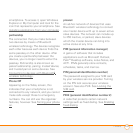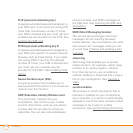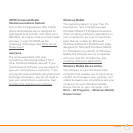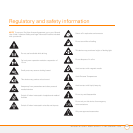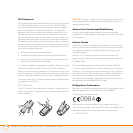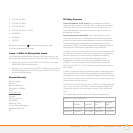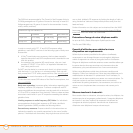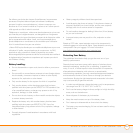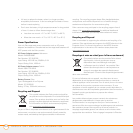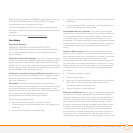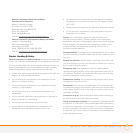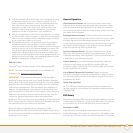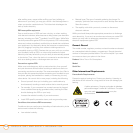
REGULATORY AND SAFETY INFORMATION
351
Par ailleurs pour éviter les risques d’interférences, les personnes
porteuses d’implants électroniques (stimulateurs cardiaques,
pompes à insuline, neurostimulateurs..) doivent conserver une
distance de 15 cm entre le mobile et l’implant et ne l’utiliser que du
côté opposé au côté où celui-ci est situé.
Téléphoner en conduisant, même avec des équipements qui ne sont
pas interdits par la réglementation, est dangereux car il augmente
potentiellement le risque d’accident provenant de la distraction créée
par la conversation elle même. Aussi, est-il recommandé de ne
jamais téléphoner en conduisant et de considérer que l’utilisation
d’un kit mains-libres n’est pas une solution.
(1)
Valeur DAS la plus élevée pour ce modèle de téléphone et pour une
utilisation à l’oreille, communiquée par le constructeur. Le DAS,
exprimé en w/kg, quantifie le niveau d’exposition aux ondes
électromagnétiques et permet de vérifier la conformité des mobiles à
la réglementation française et européenne qui impose que celui-ci
soit inférieur à 2w/kg.
Battery handling:
• Do not disassemble or open crush, bend or deform, puncture or
shred.
• Do not modify or remanufacture, attempt to insert foreign objects
into the battery, immerse or expose to water or other liquids,
expose to fire, explosion or other hazard.
• Only use the battery for the system for which it is specified.
• Only use the battery with a charging system that has been
qualified with the system per the IEEE/CTIA-1725 standard. Use
of an unqualified battery or charger may present a risk of fire,
explosion, leakage, or other hazard.
• Do not short circuit a battery or allow metallic conductive objects
to contact battery terminals.
• Replace the battery only with another battery that has been
qualified with the system per IEEE/CTIA-1725. Use of an
unqualified battery may present a risk of fire, explosion, leakage
or other hazard.
• Promptly dispose of used batteries in accordance with local
regulations.
• Battery usage by children should be supervised.
• Avoid dropping the phone or battery. If the phone or battery is
dropped, especially on a hard surface, and the user suspects
damage, take it to a service center for inspection.
• Do not handle a damaged or leaking Lithium-Ion (LI-ion) battery
as you can be burned.
• Improper battery use may result in a fire, explosion or other
hazard.
Based on DOT rules, spare batteries must not be transported in
checked luggage on commercial flights. Spare batteries can only be
transported in carry-on luggage. For more information:
http://safetravel.dot.gov/whats new batteries.html
.
Protecting Your Battery
The guidelines listed below help you get the most out of your
battery’s performance.
Recently there have been some public reports of wireless phone
batteries overheating, catching fire, or exploding. It appears that
many, if not all, of these reports involve counterfeit or inexpensive,
aftermarket-brand batteries with unknown or questionable
manufacturing standards. Use only manufacturer-approved batteries
and accessories found at Carrier Stores or through your device’s
manufacturer. Buying the right batteries and accessories is the best
way to ensure they're genuine and safe.
• In order to avoid damage, charge the battery only in temperatures
that range from 32° F to 122° F (0° C to 50° C).
• Don’t use the battery charger in direct sunlight or in high humidity
areas, such as the bathroom.
• Never dispose of the battery by incineration.
• Keep the metal contacts on top of the battery clean.
• Don't attempt to disassemble or short-circuit the battery.
• The battery may need recharging if it has not been used for a long
period of time.



